Watershed Response to Climate Change and Fire-Burns in the Upper Umatilla River Basin, USA
Abstract
:1. Introduction
2. Materials and Methods
2.1. Study Area
2.2. Hydrologic Model: Precipitation Runoff Modeling System
2.3. Climate Data
2.4. Global Climate Models
2.5. Indicators for Detecting Climate Change Impact
2.6. Generation of Hydrologic Response Units
2.7. Post-fire Analysis
2.8. Calibration and Verification
2.9. Model Evaluation
3. Results
3.1. Change in Mean Annual Temperature
3.2. Change of Temperature and Percent Change in Precipitation
3.3. Seasonal Change of Temperature and Percent Change in Precipitation
3.4. Center Time of Flow after Fire-Burns
3.5. Seasonal Flows after Fire-Burns
3.6. Ratio of Snow Water Equivalent to Precipitation before Fire-Burns
3.7. Potential Recharge after Fire-Burn
4. Discussion
4.1. Caveats of Modeling
4.2. Temperature and Precipitation
4.3. Snow Water Equivalent and Precipitation
4.4. Runoff Behavior
4.5. Potential Basin Recharge and Base-Flow
4.6. Future Work
5. Conclusions
Acknowledgments
Author Contributions
Conflicts of Interest
Appendix A
| Model Name | Model Agency | Country |
|---|---|---|
| CNRM-CM5 | Natl. Centre of Meteorological Res. | France |
| HadGEM2-ES | Met Office Hadley Ctr. | UK |
| CanESM2 | Canadian Ctr. for Climate Modeling & Analysis | Canada |
| MIROC5 | Atmosphere & Ocean Res. Inst, Japan & Natl. Inst. for Env. Studies, Japan Agency for Marine-Earth Sci. and Tech. | Japan |
| NorESM1-M | Norwegian Climate Ctr. | Norway |
| CSIRO-Mk3.6.0 | Commonwealth Sci. & Industrial Res. Org./Queensland Climate Change Ctr. of Excellence | Australia |
| MRI-CGCM3 | Meteorological Res. Inst. | Japan |
| INM-CM4 | Inst. for Numerical Mathematics | Russia |
| BCC-CSM1.1 | Beijing Climate Ctr., China Meteorological Admin. | China |
| GFDL-ESM2M | NOAA Geophysical Fluid Dynamics Laboratory | USA |
| Data | Resolution | Source |
|---|---|---|
| Historic Climate Data | 4 km | Abatzaglou (2012) |
| Future Climate Data | 4 km | Abatzaglou (2012) |
| Streamflow: U.S. Geological Survey Stream Gage 14020850 | USGS (2013) | |
| Soils: NRCS State Soils Geographic | 30 m | STATSGO (2013) |
| Land Use and Land Cover: Nat’l Land Cover Data | 30 m | USGS (2013) |
| DEM: National Elevation Dataset | 30 m | USGS (2013) |
| Point data and acres burned in the URB | U.S. Forest Service, Umatilla Natl. Forest | |
| Models and Tools | Version | |
| Precipitation Runoff Modeling System (PRMS) | 3.0.5 | USGS (2013) |
| Geo Data Portal (GDP) | USGS (2013) | |
| Let Us Calibrate (LUCA) | USGS (2013) | |
| Web-based Hydrograph Analysis Tool | Purdue University (2015) |
| Step | Calibration Dataset | Parameter Name | Final Value | Parameter Range |
|---|---|---|---|---|
| 1 | Water Balance | rain_cbh_adj_mo | 1.128 | 0.6–1.4 |
| snow_cbh_adj_mo | 1.4 | 0.6–1.4 | ||
| 2 | Daily Flow Timing (all flows) | adjmix_rain_hru_mo | 0.4–1.4 | 0.6–1.4 |
| cecn_coef | 2.12 | 2.0–10.0 | ||
| emis_noppt | 0.975 | 0.76–1.0 | ||
| freeh2o_cap | 0.019 | 0.01–0.2 | ||
| K_coef | 23.859 | 1–24.0 | ||
| potet_sublim | 0.541 | 0.1–0.75 | ||
| slowcoef_lin | 0.004 | 0.001–0.5 | ||
| soil_moist_max | 2.14–12.537 | 2–10 | ||
| soil_rechr_max | 1.643 | 1.5–5 | ||
| tmax_allrain_hru_mo | 22–52 | 34–45 | ||
| tmax_allsnow_hru | 37 | 30–40 | ||
| 3 | Daily Flow Timing (high flows) | fastcoef_lin | 0.005 | 0.001–0.8 |
| pref_flow_den | 0.1 | 0–0.1 | ||
| sat_threshold | 3.031–13.955 | 1.0–15.0 | ||
| smidx_coef | 0.001 | 0.001–0.06 | ||
| 4 | Daily Flow Timing (low flows) | gwflow_coef | 0.024 | 0.001–0.1 |
| soil2gw_max | 0.103 | 0–0.5 | ||
| ssr2gw_rate | 0.582 | 0.05–0.8 | ||
| gwflow_coef | 0.024 | 0.001–0.5 | ||
| gwsink_coef | 0.02 | 0.0–0.05 | ||
| soil2gw_max | 0.103 | 0–0.5 | ||
| ssr2gw_rate | 0.582 | 0.05–0.8 | ||
| soil_moist_max | 2.14–12.537 | 2–10 | ||
| slowcoef_sq | 0.161 | 0.05–0.3 |
References
- Oki, T.; Kanae, S. Global hydrological cycles and world water resources. Science 2006, 313, 1068–1072. [Google Scholar] [CrossRef] [PubMed]
- Kundzewicz, Z.W.; Mata, L.J.; Arnell, N.W.; Doll, P.; Kabat, P.; Jimenez, B.; Miller, K.A.; Oki, T.; SÍn, Z.; Shiklomanov, I.A. Freshwater resources and their management. In Impacts, adaptation and vulnerability. Contribution of Working Group II to the Fourth Assessment Report of the Intergovernmental Panel on Climate Change; Parry, M.L., Canziani, O.F., Palutikof, J.P., van der Linden, P.J., Hanson, C.E., Eds.; Cambridge University Press: Cambridge, UK, 2007; pp. 173–210. [Google Scholar]
- Qi, S.; Sun, G.; Wang, Y.; Mcnulty, S.; Myers, J. Streamflow response to climate and landuse changes in a coastal watershed in North Carolina. Trans. ASABE 2009, 52, 739–749. [Google Scholar] [CrossRef]
- Waibel, M.S.; Gannett, M.W.; Chang, H.; Hulbe, C.L. Spatial variability of the response to climate change in regional groundwater systems—Examples from simulations in the Deschutes Basin, Oregon. J. Hydrol. 2013, 486, 187–201. [Google Scholar] [CrossRef]
- Jung, Il-W.; Chang, H. Assessment of future runoff trends under multiple climate change scenarios in the Willamette River Basin, Oregon, USA. Hydrol. Process. 2011, 25, 258–277. [Google Scholar] [CrossRef]
- Hamlet, A.F.; Lettenmaier, D.P. Effects of 20th century warming and climate variability on flood risk in the western U.S. Water Resour. Res. 2007, 43, 1–17. [Google Scholar] [CrossRef]
- Abatzoglou, J.T.; Rupp, D.; Mote, P. Understanding seasonal climate variability and change in the Pacific Northwest of the United States. J. Clim. 2014, 27, 2125–2142. [Google Scholar] [CrossRef]
- Chang, H.J.; Jung, I.W. Spatial and temporal changes in runoff caused by climate change in a complex large river basin in Oregon. J. Hydrol. 2010, 388, 186–207. [Google Scholar] [CrossRef]
- Elsner, M.; Cuo, L.; Voisin, N.; Deems, J.; Hamlet, A.; Vano, J.; Mickelson, K.; Lee, S.; Lettenmaier, D. Implications of 21st century climate change for the hydrology of Washington State. Clim. Chang. 2010, 102, 225–260. [Google Scholar] [CrossRef]
- Hamlet, A.F.; Carrasco, P.; Deems, J.; Elsner, M.M.; Kamstra, T.; Lee, C.; Mauger, G.; Salathe, E.P.; Tohver, I.; Whitely Binder, L. Final Project Report for the Columbia Basin Climate Change Scenarios Project. 2010. Available online: http://warm.astmos.washington.edu/2860/report/ (accessed on 1 August 2015).
- Surfleet, C.G.; Tullos, D.; Chang, H.; Jung, I.-W. Selection of hydrologic modeling approaches for climate change assessment: A comparison of model scale and structures. J. Hydrol. 2012, 464–465, 233–248. [Google Scholar] [CrossRef]
- Knowles, N.; Dettinger, M.D.; Cayan, D.R. Trends in snowfall versus rainfall in the western United States. J. Clim. 2006, 19, 4545–4559. [Google Scholar] [CrossRef]
- Abatzoglou, J.T. Influence of the PNA on declining mountain snowpack in the Western United States. Int. J. Climatol. 2011, 31, 1135–1142. [Google Scholar] [CrossRef]
- Mote, P.W.; Hamlet, A.F.; Clark, M.P.; Lettenmaier, D.P. Declining mountain snowpack in western North America. Bull. Am. Meteorol. Soc. 2005, 86, 6. [Google Scholar] [CrossRef]
- Mastin, M.C.; Chase, K.J.; Dudley, R.W. Changes in spring snowpack for selected basins in the United States for different climate-change scenarios. Earth Interact. 2011, 15, 1–18. [Google Scholar] [CrossRef]
- Mote, P.W.; Parson, E.A.; Hamlet, A.F.; Keeton, W.S.; Lettenmaier, D.; Mantua, N.; Miles, E.L.; Peterson, D.W.; Peterson, D.L.; Slaughter, H.; et al. Preparing for climatic change: The water, salmon, and forests of the Pacific Northwest. Clim. Chang. 2003, 61, 45–88. [Google Scholar] [CrossRef]
- Jung, I.; Chang, H. Climate change impacts on spatial patterns in drought risk in the Willamette River Basin, Oregon, USA. Theor. Appl. Climatol. 2011, 108, 355–371. [Google Scholar] [CrossRef]
- Drost, B.; Whiteman, K.J. Washington Department of Ecology. In Surficial Geology, Structure, and Thickness of Selected Geohydrologic Units in the Columbia Plateau, Washington; U.S Geological Survey Water-Resources Investigations Report 84–4326; Washington Department of Ecology: Tacoma, DC, USA, 1986. [Google Scholar]
- Vaccaro, J.J. Plan of Study for the Regional Aquifer-System Analysis, Columbia Plateau, Washington, Northern Oregon, and Northwestern Idaho Water-Resources Investigations Report 85-4151; U.S. Department of the Interior, U.S. Geological Survey: Tacoma, WA, USA, 1986.
- Tolan, T.L.; Reidel, S.P.; Beeson, M.H.; Anderson, J.L.; Fecht, K.R.; Swanson, D.A. Revisions to the areal extent and volume of the Columbia River Basalt Group (CRBG). Geol. Soc. Am. 1987, 19, 458. [Google Scholar]
- Bauer, H.H.; Vaccaro, J.J. Estimates of Groundwater Recharge to the Columbia Plateau Regional Aquifer System, Washington, Oregon, and Idaho, for Predevelopment and Current Land-Use Conditions Water Resources Investigations Report 88–4108; U.S. Geological Survey: Tacoma, WA, USA, 1990.
- Chang, H.; Psaris, M. Local landscape predictors of maximum stream temperature and thermal sensitivity in the Columbia River Basin, USA. Sci. Tot. Environ. 2013, 461–462, 587–600. [Google Scholar] [CrossRef] [PubMed]
- Burns, E.R.; Snyder, D.T.; Haynes, J.V.; Waibel, M.S. Groundwater status and trends for the Columbia Plateau Regional Aquifer System, Washington, Oregon, and Idaho Scientific Investigations Report 2012–5261. U.S. Department of the Interior, U.S. Geological Survey, 2012. Available online: http://pubs.er.usgs.gov/publications/sir20125261 (accessed on 1 September 2013). [Google Scholar]
- Hansen, A.J.; Vaccaro, J.J.; Bauer, H.H. Ground-Water Flow Simulation of the Columbia Plateau Regional Aquifer System, Washington, Oregon, and Idaho Water-Resources Investigations Report 91–4187; U.S. Department of the Interior, U.S. Geological Survey: Tacoma, WA, USA, 1994.
- Moody, J.A.; Martin, D.A. Post-fire, rainfall intensity—Peak discharge relations for three mountainous watersheds in the western USA. Hydrol. Process. 2001, 15, 2981–2993. [Google Scholar] [CrossRef]
- Vieira, D.; Fernández, C.; Vega, J.; Keizer, J. Does soil burn severity affect the post-fire runoff and interrill erosion response? A review based on meta-analysis of field rainfall simulation data. J. Hydrol. 2015, 523, 452–464. [Google Scholar] [CrossRef]
- Cerda, A. Post-fire dyamics of erosional processes under mediterranean climatic conditions. Z. Feur Geomorphol. Neue Folge 1998, 42, 373–398. [Google Scholar]
- Martin, D.A.; Moody, J.A. Comparison of soil infiltration rates in burned and unburned mountainous watersheds. Hydrol. Process. 2001, 15, 2893–2903. [Google Scholar] [CrossRef]
- Robichaud, P.R. Measurement of post-fire hillslope erosion to evaluate and model rehabilitation treatment effectiveness and recovery. Int. J. Wildland. Fire 2005, 14, 475–485. [Google Scholar] [CrossRef]
- Turner, D.P.; Conklin, D.R.; Bolte, J.P. Projected climate change impacts on forest land cover and land use over the Willamette River Basin, Oregon, USA. Clim. Chang. 2015, 133, 335. [Google Scholar] [CrossRef]
- Rulli, M.C.; Offeddu, L.; Santini, M. Modeling post-fire water erosion mitigation strategies. Hydrol. Earth Syst. Sci. 2013, 17, 2323–2337. [Google Scholar] [CrossRef]
- Terranova, O.; Antronico, L.; Coscarelli, R.; Iaquinta, P. Soil erosion risk scenarios in the Mediterranean environment using RUSLE and GIS: An application model for Calabria (Southern Italy). Geomorphology 2009, 112, 228–245. [Google Scholar] [CrossRef]
- Sheehan, T.; Bachelet, D.; Ferschweiler, K. Projected major fire and vegetation changes in the Pacific Northwest of the conterminous United States under selected CMIP5 climate futures. Ecol. Model. 2015, 317, 16–29. [Google Scholar] [CrossRef]
- Oregon Water Resources Department. Available online: https://www.oregon.gov/owrd/Pages/law/integrated_water_supply_strategy.aspx (accessed on 15 October 2015).
- Umatilla River Subbasin Local Advisory Committee, Oregon State Deptartment of Agriculture, & Umatilla Soil Water Conservation District. Umatilla Agricultural Water Quality Management Area Plan; The Umatilla Local Advisory Committee: Umatilla, FL, USA, 2012.
- Ely, K. Water Resources Status, A Study of the Water Resources Availability and Demand in the Umatilla River Basin, Oregon; U.S. Bureau of Indian Affairs: Pendleton, OR, USA, 2001.
- Jones, K.L.; Poole, G.C.; Quaempts, E.J.; O’Daniel, E.; Beechie, T. Umatilla River Vision Report. 2008. Available online: http://ctuir.org/DNRUmatillaRiverVision.pdf (accessed on 1 September 2013).
- Hughes, M. Channel Change of the Upper Umatilla River during and between Flood Periods: Variability and Ecological Implications. Ph.D. Thesis, University of Oregon, Eugene, OR, USA, 2008. [Google Scholar]
- Ely, K. Groundwater and surface water are they related? Confed. Umatilla J. 2012, 16, 31. [Google Scholar]
- U.S. Forest Service. Umatilla and Meacham Ecosystem Analysis; USDA Forest Service Pacific Northwest Region Umatilla National Forest: Pendleton, OR, USA, 2001.
- Confederated Tribes of the Umatilla Indian Reservation. Forest Management Plan: An Ecological Approach to Forest Management; Mason Bruce & Gerard, Inc. Publication: Bothell, WA, USA, 2010. [Google Scholar]
- Homer, C.G.; Dewitz, J.A.; Yang, L.; Jin, S.; Danielson, P.; Xian, G.; Coulston, J.; Herold, N.D.; Wickham, J.D.; Megown, K. Completion of the 2011 national land cover database for the conterminous United States-Representing a decade of land cover change information. Photogr. Eng. Rem. Sens. 2015, 81, 345–354. [Google Scholar]
- Markstrom, S.L.; Regan, R.S.; Hay, L.E.; Viger, R.J.; Webb, R.M.T.; Payn, R.A.; LaFontaine, J.H. PRMS-IV, the Precipitation-Runoff Modeling System, Version 4: U.S. Geological Survey Techniques and Methods; U.S. Geological Survey: Reston, VA, USA, 2015.
- Abatzoglou, J.T. Development of gridded surface meteorological data for ecological applications and modelling. Int. J. Climatol. 2013, 33, 121–131. [Google Scholar] [CrossRef]
- Mitchell, K.E.; Lohmann, D.; Houser, P.R.; Wood, E.F.; Schaake, J.C.; Robock, A.; Cosgrove, B.A.; Sheffield, J.; Duan, Q.; Luo, L.; et al. The multi-institution North American Land Data Assimilation System (NLDAS): Utilizing multiple GCIP products and partners in a continental distributed hydrological modeling system. J. Geophys. Res. 2004, 109, 1–32. [Google Scholar] [CrossRef]
- Daly, C.; Halbleib, M.; Smith, J.; Gibson, W.; Doggett, M.; Taylor, G.; Curtis, J.; Pasteris, P. Physiographically sensitive mapping of climatological temperature and precipitation across the conterminous United States. Int. J. Climatol. 2008, 28, 2031–2064. [Google Scholar] [CrossRef]
- Abatzoglou, J.T.; Brown, T.J. A comparison of statistical downscaling methods suited for wildfire applications. Int. J. Climatol. 2012, 32, 772–780. [Google Scholar] [CrossRef]
- Taylor, K.E.; Stouffer, R.J.; Meehl, G.A. An overview of CMIP5 and the experiment design. Bull. Am. Meteorol. Soc. 2011, 93, 485–498. [Google Scholar] [CrossRef]
- Van Vuuren, D.; Edmonds, J.; Kainuma, M.; Riahi, K.; Thomson, A.; Hibbard, K.; Rose, S. The representative concentration pathways: An overview. Clim. Chang. 2011, 109, 5–31. [Google Scholar] [CrossRef]
- Blodgett, D.L.; Booth, N.L.; Kunicki, T.C.; Walker, J.L.; Viger, R.J. Description and Testing of the Geo Data Portal: A Data Integration Framework and Web Processing Services for Environmental Science Collaboration; Open-File Report 2011–1157; U.S. Deptartment of Interior, U.S. Geological Survey: Reston, VA, USA, 2011.
- Rupp, D.; Abatzoglou, J.; Hegewisch, K.; Mote, P. Evaluation of CMIP5 20th century climate simulations for the Pacific Northwest USA. J. Geophys. Res. 2013, 118, 10884–10906. [Google Scholar]
- Mote, P.; Brekke, L.; Duffy, P.; Maurer, E. Guidelines for constructing climate scenarios. EOS Trans. Am. Geophys. Union 2011, 92, 257–258. [Google Scholar] [CrossRef]
- Leavesley, G.H.; Lichty, R.W.; Troutman, B.M.; Saindon, L.G. Precipitation Runoff Modeling System: User’s Manual -Water-Resources Investigations Report 83–4238; US Geological Survey: Denver, CO, USA, 1983.
- Konrad, C. Simulated Water-Management Alternatives Using the Modular Modeling System for the Methow River Basin, Washington U.S; Geological Survey Open-File Report 2004–1051; U.S. Department of the Interior, U.S. Geological Survey: Denver, CO, USA, 2004.
- Ebert, B.U.S.; Forest Service, Pendleton, OR, USA. Personal Communication, 2015.
- Hay, L.E.; Umemoto, M. Multiple-Objective Stepwise Calibration Using LUCA: U.S. Geological Survey Open-File Report 2006–1323; US Geological Survey Water-Resources Investigations Report: Washington, DC, USA, 2006.
- Krause, P.; Boyle, D.P.; Bäse, F. Comparison of different efficiency criteria for hydrological model assessment. Adv. Geosci. 2005, 5, 89–97. [Google Scholar] [CrossRef]
- Moriasi, D.N.; Arnold, J.G.; Van Liew, M.W.; Binger, R.L.; Harmel, R.D.; Veith, T.L. Model evaluation guidelines for systematic quantification of accuracy in watershed simulations. Trans. ASABE. 2007, 50, 885–900. [Google Scholar] [CrossRef]
- Gupta, H.; Kling, H.; Yilmaz, K.; Martinez, G. Decomposition of the mean squared error and NSE performance criteria; implications for improving hydrological modelling. J. Hydrol. 2009, 377, 80–91. [Google Scholar] [CrossRef]
- Confederated Tribes of the Umatilla Indian Reservation. Meacham Creek Flood Restoration and In-stream Enhancement Project Completion Report; Tetra Tech Inc. Publication: Portland, OR, USA, 2012. [Google Scholar]
- Cooper, R.M. Determining Surface Water Availability in Oregon, State of Oregon Water Resources Department, Open File Report SW 02-002; State of Oregon, Water Resources Department: Salem, OR, USA, 2002.
- Ely, K.; Department of Natural Resources, Confederated Tribes of the Umatilla Indian Reservation, Pendleton, OR, USA. Personal Communication, 2013.
- Cherkauer, D. Quantifying ground water recharge at multiple scales using PRMS and GIS. Ground Water 2004, 42, 97–110. [Google Scholar] [CrossRef] [PubMed]
- Dickerson-Lange, S.; Mitchell, R. Modeling the effects of climate change projections on streamflow in the Nooksack River Basin, Northwest Washington. Hydrol. Process. 2014, 28, 5236–5250. [Google Scholar] [CrossRef]
- Stacy, V.; Reder, B.; Hamilton, R.; Doppelt, B.; Dello, K.; Sharp, D. Projected Future Conditions in the Umatilla River Basin of Northeast Oregon; Report: Oregon Climate Change Research Institute, Climate Leadership Initiative Institute for a Sustainable Environment; University of Oregon: Eugen, OR, USA, 2010. [Google Scholar]
- Stewart, I.T.; Cayan, D.R.; Dettinger, M.D. Changes toward earlier streamflow timing across western North America. J. Clim. 2005, 18, 1136–1155. [Google Scholar] [CrossRef]
- Hamlet, A.F. Assessing water resources adaptive capacity to climate change impacts in the Pacific Northwest Region of North America. Hydrol. Earth Syst. Sci. 2011, 15, 1427–1443. [Google Scholar] [CrossRef]
- Safeeq, M.; Grant, G.; Lewis, S.; Tague, C. Coupling snowpack and groundwater dynamics to interpret historical streamflow trends in the western United States. Hydrol. Process. 2013, 27, 655–668. [Google Scholar] [CrossRef]
- Spane, F.; Webber, W. Hydrochemistry and Hydrogeologic Conditions within the Hanford Site Upper Basalt Confined Aquifer System; PNNL-10817; U.S. Department of Energy: Richland, WA, USA, 1995.
- Pendleton Public Works Water Division. City of Pendleton Water Management Plan; Pendleton Public Works Water Division: Pendleton, OR, USA, 2010. [Google Scholar]
- MacDonald, L.; Huffman, E. Post-fire soil water repellency; persistence and soil moisture thresholds. Soil Sci. Soc. Am. J. 2004, 68, 1729–1734. [Google Scholar] [CrossRef]
- Henderson, G.; Golding, D. The effect of slash burning on the water repellency of forest soils at Vancouver, British Columbia. Can. J. For. Res. 1983, 13, 353–355. [Google Scholar] [CrossRef]
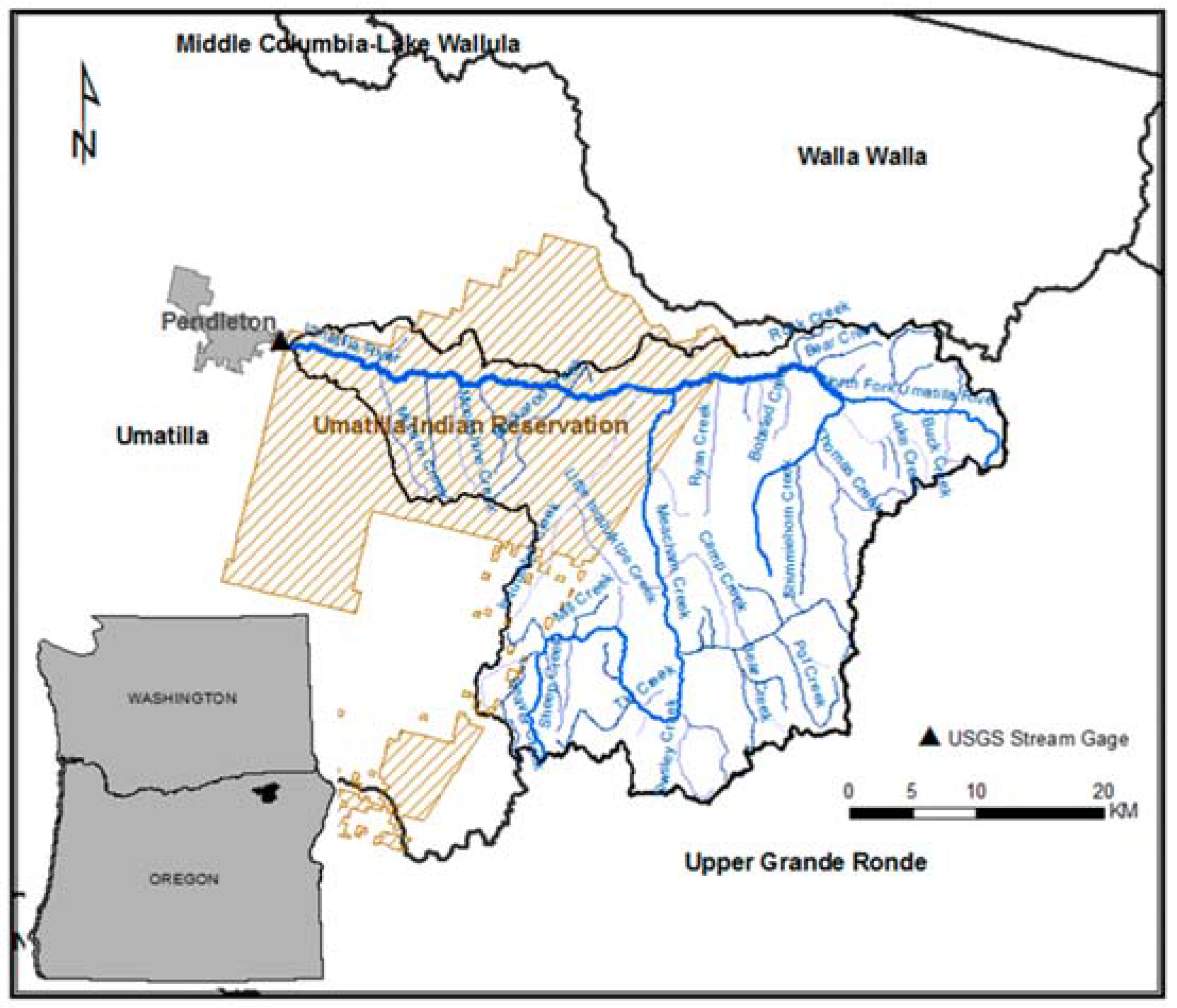
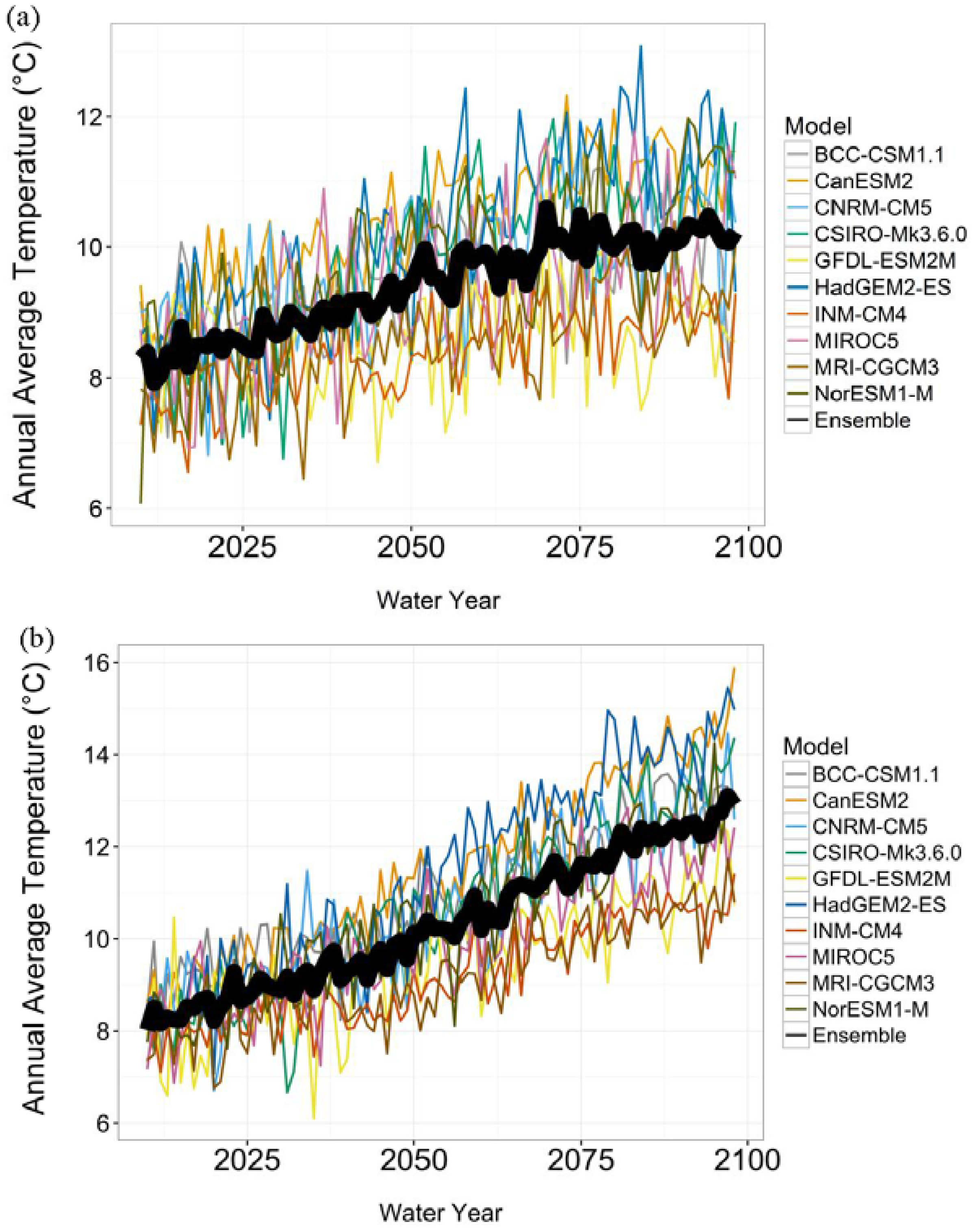
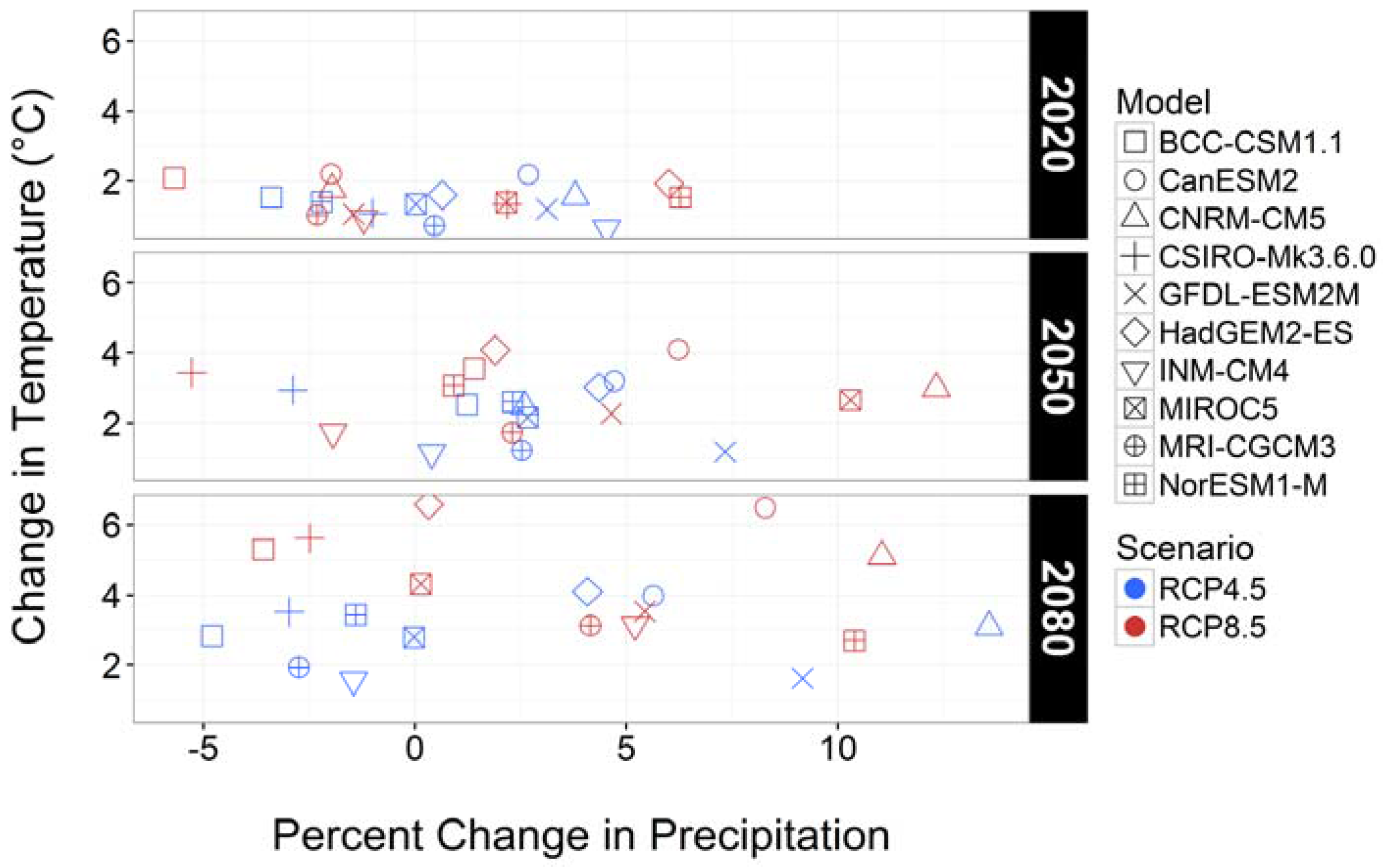
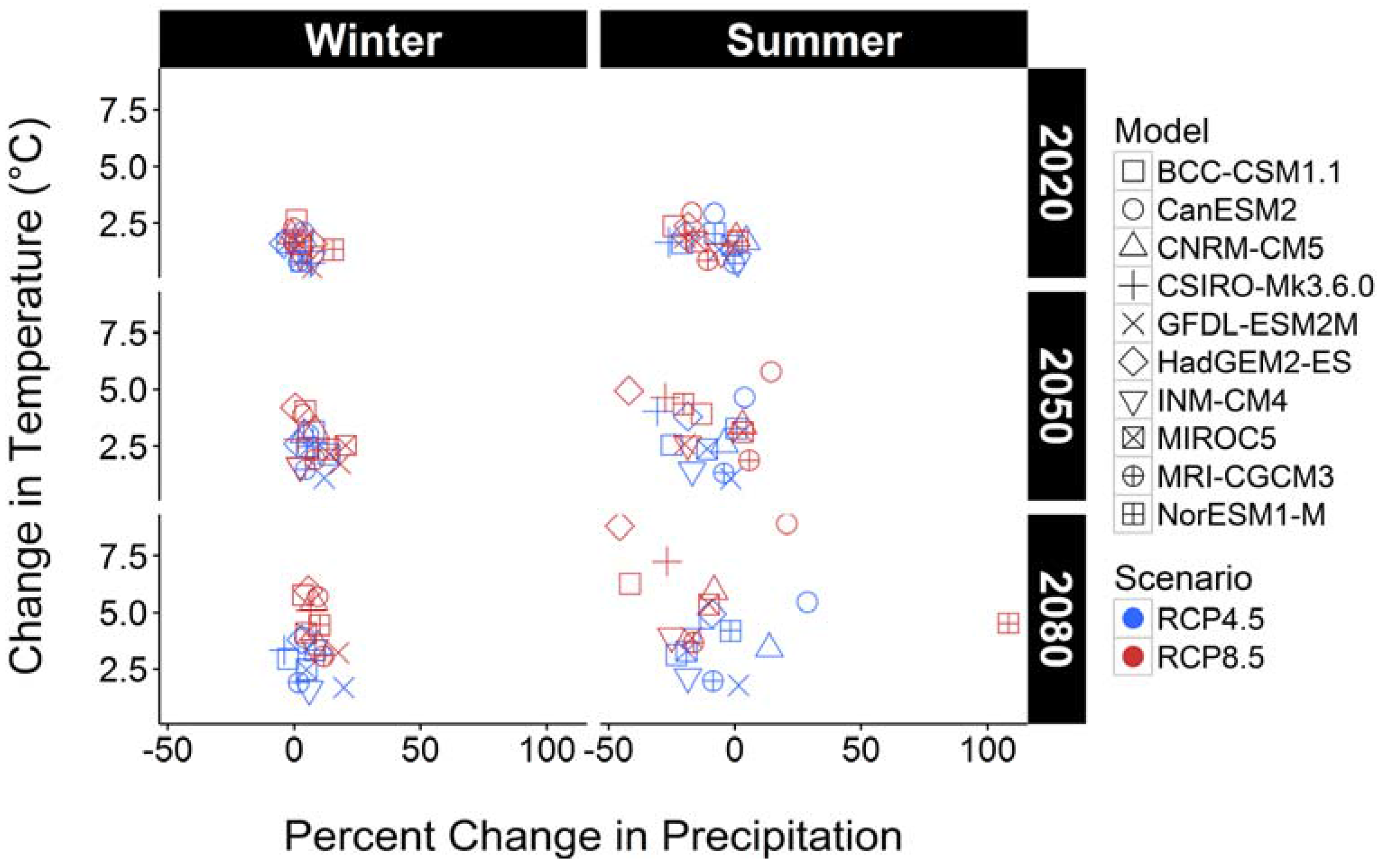
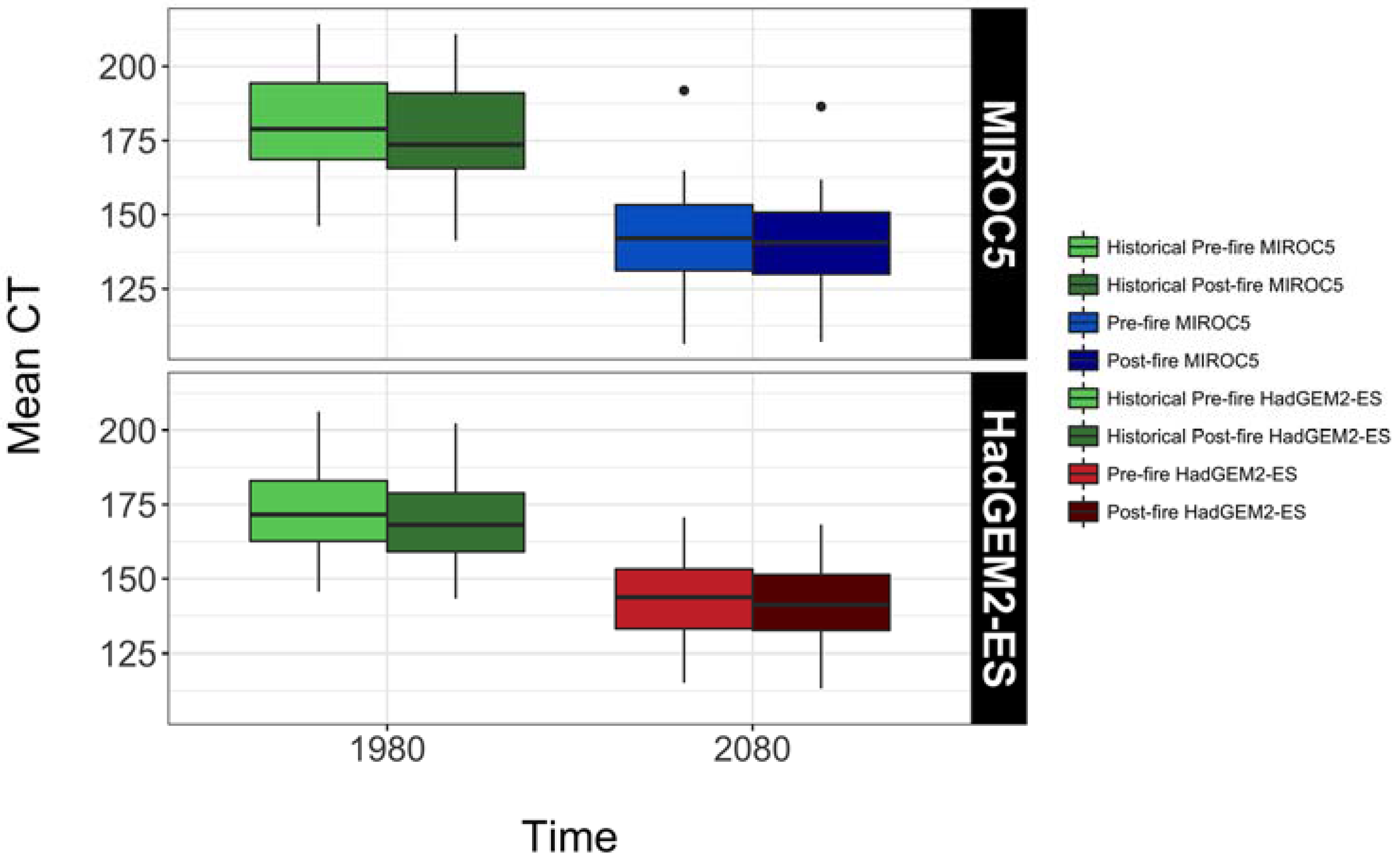
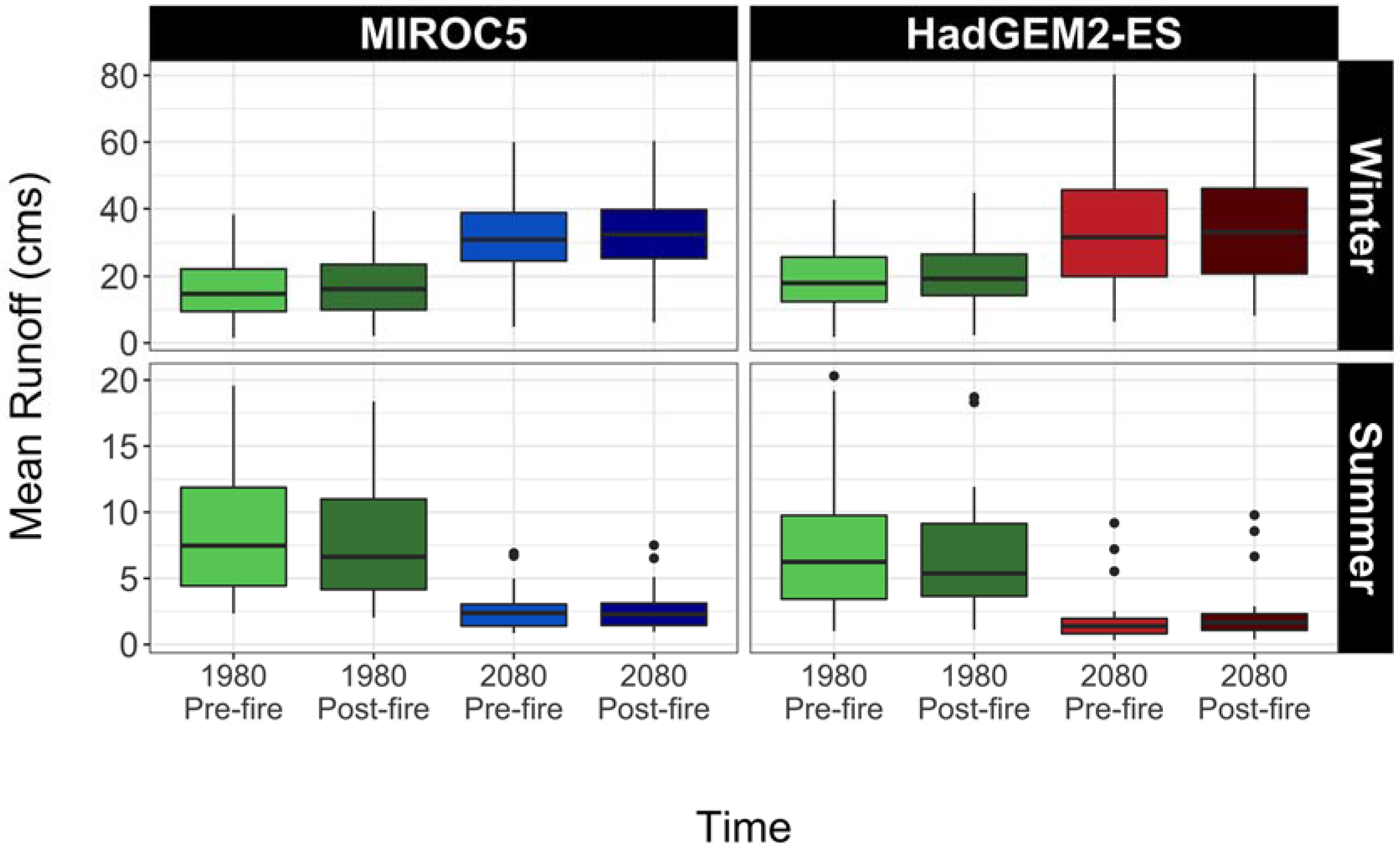
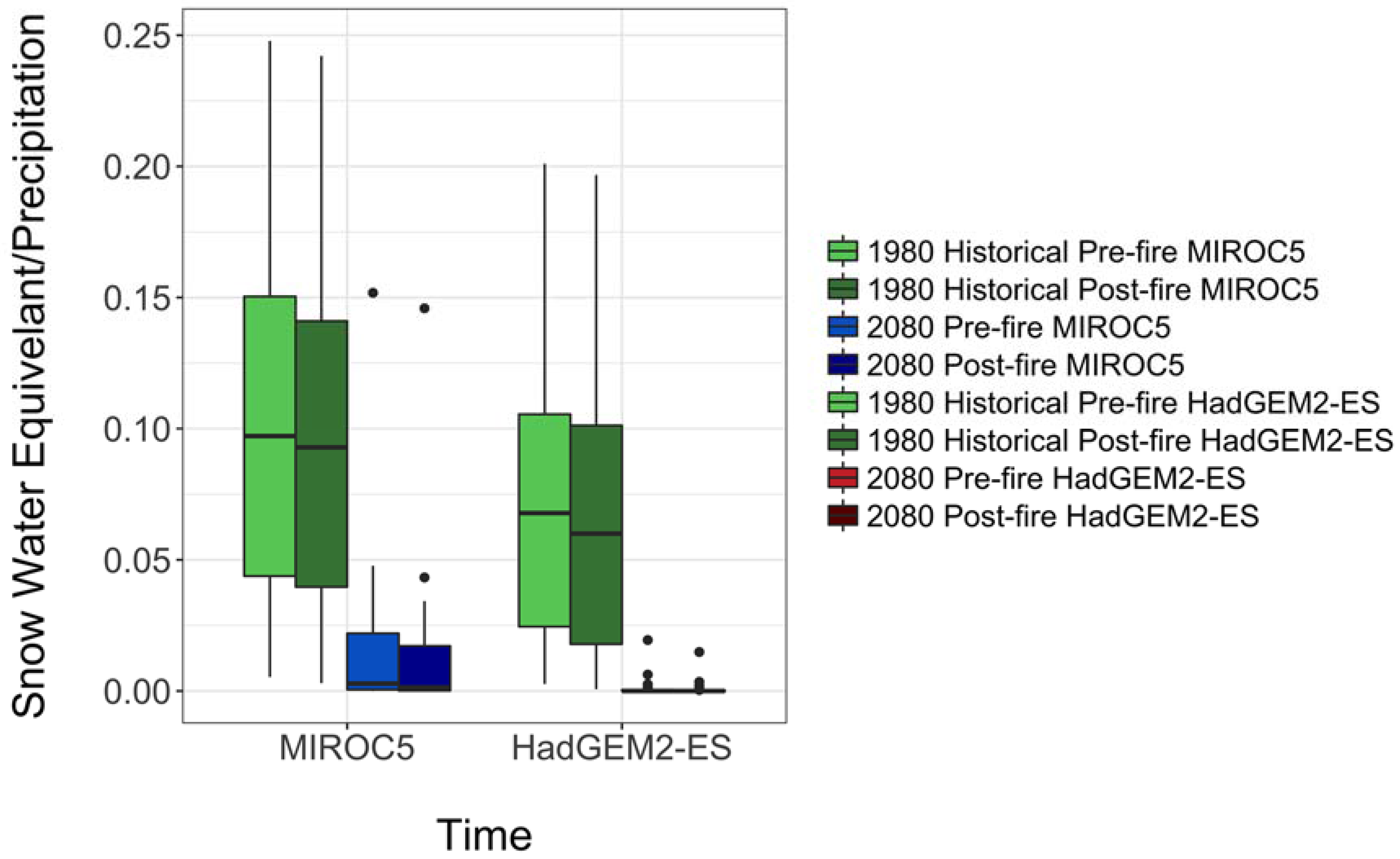
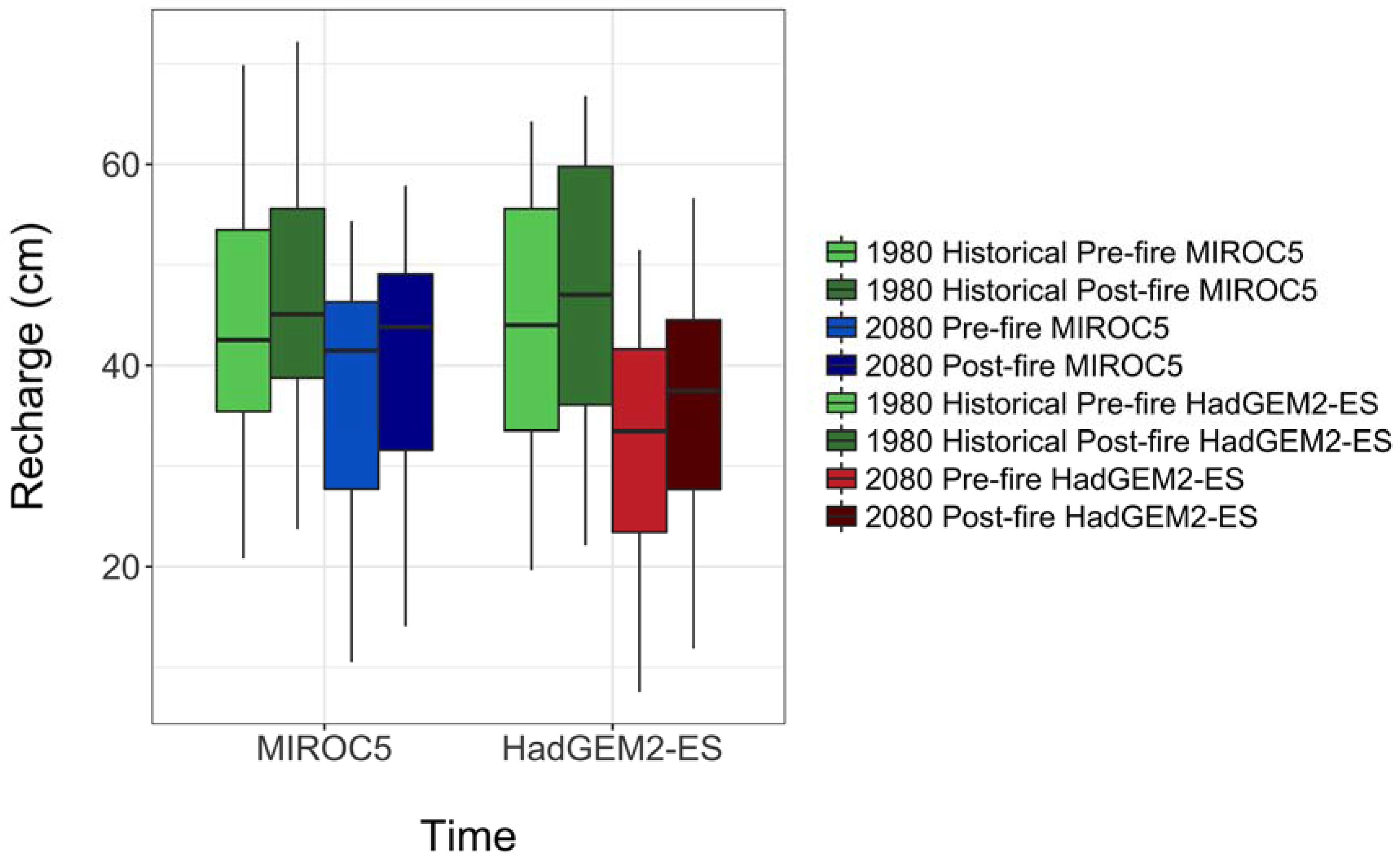
| Description | Initial | Assigned | % Δ | |
|---|---|---|---|---|
| COVDEN_SUM | Summer vegetation cover density | 0.5 | 0.1 | −80% |
| COVDEN_WIN | Winter vegetation cover density | 0.5 | 0.1 | −80% |
| RAD_TRNCF | Solar radiation transmission | 0.3 | 0.5 | 40% |
| SOIL_RECHR_MAX | Max. storage for soil recharge zone | 1.643 | 0.55 | −67% |
| SOIL_MOIST_MAX | Max. value of water for soil zone | 2.14–12.537 | 1.08 | −50% |
| NSE | % Bias | KGE | NRMSE | |
|---|---|---|---|---|
| Initial Model Results | 0.04 | 4 | 0.57 | 97.7 |
| After Calibration (1995–2010) | 0.73 | 3.5 | 0.81 | 52.2 |
| Validation (2010–2014) | 0.73 | 3.5 | 0.83 | 52.1 |
| Ensemble Mean | MIROC5 | HadGEM2-ES | |||||||||||
|---|---|---|---|---|---|---|---|---|---|---|---|---|---|
| Hist. | RCP 4.5 | RCP 8.5 | RCP 4.5 | RCP 8.5 | |||||||||
| 1980s | 2050s | 2080s | 2050s | 2080s | Pre 1980s | Post 1980s | Pre 2080s | Post 2080s | Pre 1980s | Post 1980s | Pre 2080s | Post 2080s | |
| Δ in days in μ CT | 6/23 175 | 5/31 152 | 5/27 148 | 5/29 150 | 5/22 143 | 6/29 181 | 6/24 176 | 5/23 144 | 5/20 141 | 6/20 172 | 6/17 169 | 5/21 142 | 5/19 140 |
| σ | 17.32 | 14.76 | 15.83 | 16.23 | 15.72 | 17.26 | 17.15 | 14.07 | 16.26 | 15.32 | 13.77 | 14.23 | 14.04 |
| MIROC5 | HadGEM2-ES | |||||||||||||||
|---|---|---|---|---|---|---|---|---|---|---|---|---|---|---|---|---|
| 1980s Hist. | 2080s RCP 4.5 | 1980s Hist. | 2080s RCP 8.5 | |||||||||||||
| Pre-fire | Post-fire | Pre-fire | Post-fire | Pre-fire | Post-fire | Pre-fire | Post-fire | |||||||||
| μ Runoff (cm3/s) | WTR | SMR | WTR | SMR | WTR | SMR | WTR | SMR | WTR | SMR | WTR | SMR | WTR | SMR | WTR | SMR |
| 15.93 | 8.84 | 17.22 | 8.30 | 30.68 | 2.47 | 31.99 | 2.66 | 18.95 | 7.12 | 20.36 | 6.77 | 33.92 | 1.93 | 35.03 | 2.23 | |
| Min | 1.53 | 2.34 | 2.07 | 2.03 | 4.77 | 0.86 | 6.15 | 0.95 | 1.78 | 1.01 | 2.32 | 1.12 | 6.33 | 0.32 | 8.17 | 0.39 |
| Max | 8.36 | 19.57 | 39.31 | 18.38 | 60.01 | 6.91 | 60.38 | 7.5 | 42.66 | 20.3 | 44.79 | 18.71 | 80.29 | 9.17 | 80.54 | 9.78 |
| % Δ | 92.59 | −72.06 | 85.77 | −67.95 | 79.00 | −72.89 | 72.05 | −67.06 | ||||||||
| σ | 9.71 | 5.13 | 9.86 | 4.72 | 12.35 | 1.56 | 12.16 | 1.68 | 8.67 | 4.67 | 8.74 | 4.27 | 16.43 | 2.01 | 16.11 | 2.25 |
| Ensemble Mean | ||||||||||
|---|---|---|---|---|---|---|---|---|---|---|
| Hist. | RCP 4.5 | RCP 8.5 | ||||||||
| 1980s | 2050s | 2080s | 2050s | 2080s | ||||||
| μ Runoff (cm3/s) | WTR | SMR | WTR | SMR | WTR | SMR | WTR | SMR | WTR | SMR |
| 17.69 | 6.916 | 29.26 | 3.51 | 30.33 | 3.27 | 30.63 | 3.35 | 35.36 | 2.37 | |
| Min | 10.3 | 4.746 | 21.74 | 1.99 | 24.30 | 2.09 | 22.40 | 2.20 | 27.99 | 1.54 |
| Max | 25.26 | 10.092 | 36.28 | 4.69 | 39.02 | 5.13 | 44.50 | 5.13 | 44.74 | 3.48 |
| % Δ | 65.40 | −49.24 | 71.45 | −52.71 | 73.14 | −51.56 | 98.89 | −65.73 | ||
| σ | 3.97 | 1.32 | 3.55 | 0.61 | 3.38 | 0.72 | 4.82 | 0.98 | 4.19 | 0.50 |
| Ensemble Mean | MIROC5 RCP 4.5 | HadGEM2-ES RCP 8.5 | |||||||||||
|---|---|---|---|---|---|---|---|---|---|---|---|---|---|
| Hist. | RCP 4.5 | RCP 8.5 | Pre-fire | Post-fire | Pre-fire | Post-fire | Pre-fire | Post-fire | Pre-fire | Post-fire | |||
| 1980s | 2050s | 2080s | 2050s | 2080s | 1980s | 1980s | 2080s | 2080s | 1980s | 1980s | 2080s | 2080s | |
| μ SWE (cm) | 6.6 | 1.97 | 1.37 | 1.43 | 0.72 | 8.40 | 8.04 | 1.33 | 1.15 | 6.38 | 4.42 | 0.08 | 0.05 |
| μ P (cm) | 75.7 | 79.23 | 78.19 | 79.46 | 81.08 | 77.20 | 77.20 | 79.74 | 79.74 | 76.96 | 77.14 | 79.89 | 79.89 |
| μ SWE/P | 0.08 | 0.02 | 0.015 | 0.016 | 0.0072 | 0.11 | 0.104 | 0.02 | 0.01 | 0.08 | 0.079 | 0.001 | 0.00626 |
| % Δ | −75.0 | −81.25 | −80.0 | −91.0 | −81.81 | −90.3 | −98.75 | −99.20 | |||||
| σ | 0.059 | 0.027 | 0.026 | 0.024 | 0.029 | 0.069 | 0.069 | 0.029 | 0.028 | 0.054 | 0.056 | 0.003 | 0.002 |
| Ensemble Mean | MIROC5 | HadGEM2-ES | |||||||||||
|---|---|---|---|---|---|---|---|---|---|---|---|---|---|
| Hist. | RCP 4.5 | RCP 8.5 | Pre-fire | Post-fire | Pre-fire | Post-fire | Pre-fire | Post-fire | Pre-fire | Post-fire | |||
| 1980s | 2050s | 2080s | 2050s | 2080s | 1980s | 1980s | 2080s | 2080s | 1980s | 1980s | 2080s | 2080s | |
| μ Recharge | 42.77 | 40.71 | 38.36 | 39.60 | 36.46 | 44.55 | 47.20 | 37.89 | 40.87 | 43.73 | 46.54 | 32.14 | 36.06 |
| Min | 15.23 | 8.29 | 6.63 | 6.03 | 6.31 | 20.82 | 23.73 | 10.5 | 14.07 | 19.65 | 22.11 | 7.55 | 11.87 |
| Max | 72.79 | 75.62 | 77.60 | 70.63 | 75.09 | 69.88 | 72.20 | 54.36 | 57.88 | 64.26 | 66.79 | 51.48 | 56.65 |
| % Δ | −4.82 | −10.31 | −7.41 | −14.75 | −14.95 | −13.41 | −26.50 | −22.51 | |||||
| σ | 11.19 | 12.07 | 11.34 | 11.75 | 11.44 | 12.96 | 12.75 | 11.11 | 10.86 | 13.75 | 13.79 | 11.65 | 11.59 |
© 2017 by the authors. Licensee MDPI, Basel, Switzerland. This article is an open access article distributed under the terms and conditions of the Creative Commons Attribution (CC BY) license ( http://creativecommons.org/licenses/by/4.0/).
Share and Cite
Yazzie, K.; Chang, H. Watershed Response to Climate Change and Fire-Burns in the Upper Umatilla River Basin, USA. Climate 2017, 5, 7. https://doi.org/10.3390/cli5010007
Yazzie K, Chang H. Watershed Response to Climate Change and Fire-Burns in the Upper Umatilla River Basin, USA. Climate. 2017; 5(1):7. https://doi.org/10.3390/cli5010007
Chicago/Turabian StyleYazzie, Kimberly, and Heejun Chang. 2017. "Watershed Response to Climate Change and Fire-Burns in the Upper Umatilla River Basin, USA" Climate 5, no. 1: 7. https://doi.org/10.3390/cli5010007
APA StyleYazzie, K., & Chang, H. (2017). Watershed Response to Climate Change and Fire-Burns in the Upper Umatilla River Basin, USA. Climate, 5(1), 7. https://doi.org/10.3390/cli5010007






